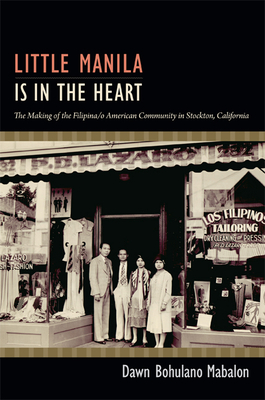Little Manila Is in the Heart: The Making of the Filipina/o American Community in Stockton, California
Dawn Bohulano Mabalon

I mentioned Dawn Mabalon already in my review of her co-authored children’s book, “Journey for Justice.” Sadly, I only learned about her this year because of her very untimely death.
From all accounts (and I’ve listened to a few, both recorded and in direct conversation with people who met or knew her), she was a really extraordinary person, who to me was the ideal blend of academic and activist–someone who studied her subject matter deeply as one part of a concerted effort to bring more justice into the world. I’ll just recount one small anecdote. My wife and I were talking with Romy Dorotan, the chef and co-owner of the Brooklyn Filipino restaurant/institution Purple Yam, a few months after Mabalon died. He had known her personally and had her picture up on the wall, which is what started our conversation. I said something to him about it being Filipino-American National Heritage Month, and he immediately (although in a nice grandfatherly way) stepped in–it’s “History” month, not “Heritage” month, he said; Dawn would have corrected you on that, because “Heritage” implies that the only important thing is the background brought from another country, but “History” includes the struggles of Filipina/o-Americans since they came to this country too. That gave me a little picture of the kind of thoughtful and committed person she was–and I’m sure I won’t make the same mistake again!
Mabalon was a professor of history at San Francisco State University, and the co-founder of the Little Manila Foundation in Stockton, her hometown. This book is the expanded version of her dissertation. As the title implies, it covers the history of the Filipina/o-American (to use her preferred stylization) community in Stockton, an agricultural city that was one of the main destinations of Filipina/o immigrants to the west coast. The telling of this story itself is a type of activism since, as the book covers, while Filipina/os have lived in Stockton since the early 20th century, the “Little Manila” part of the city was almost wholly demolished for a freeway construction project during the “urban renewal” era, and the Filipina/o-American community’s memory of itself was pretty effectively destroyed by this as well–a combination of the lack of political representation in the city and of the strongly generational character of Filipina/o migration (later waves, largely professionals, were from very different classes than earlier waves, who largely worked as farm laborers–even when they were educated professionals). Mabalon’s Little Manila foundation is of course a part of this activism as well.
The book itself was really interesting to me, too. Mabalon’s writing is, partly by necessity, a blend of traditional historiography and drawing on her own family history. I mentioned this to my wife Elise, and she said that this hybrid style has been innovated by scholars of color because in so many cases, as in this one, traditional records and archival sources of their communities were either never created or were actively destroyed. Really there’s too much to cover in a short review, but some of the interesting things I learned about from this book were:
- The way early immigrants from the Philippine islands didn’t really consider themselves as “Filipinos”, but rather as Visayans, Ilocanos, Tagalogs, etc. (different linguistic/regional groups). There was no real formation of a “Filipino” identity until the issue was forced by white Americans lumping them all together and constructing them as a racial group, necessitating a unified response.
- Although I usually assume Filipina/os are almost universally Catholic, Mabalon paints a much more complex picture. Because Filipino Catholicism has its own unique character, many immigrants did not feel a connection to the (largely Irish at the time) American Catholic church, not to mention the fact that they were often racially discriminated against. As such, many of them actually became Protestants for a long period, because Protestant churches saw an opening and, while they were still fairly paternalistics, were at least more welcoming. This only changed when (a) a group of Filipina nuns came to California, and (b) more radical justice-oriented priests arrived on the scene in the 1960s.
- Although I’m sure it must have been alluded to in Carlos Bulosan’s “America is in the Heart,” I had not given much thought to the extreme gender imbalance between early Filipina/o immigrants—Mabalon puts it around 90% male, due to most of the demand being for agricultural laborers. This quirk of history had so many impacts, both good (tipping the balance of power in favor of women) and bad (because racist laws barred Filipino men from marrying white women, men ended up patronizing “taxi-dance girls” and prostitutes, which resulted in white society passing judgment on their moral character).
- It was World War II and, very specifically, the Bataan death march, that finally changed white American views about Filipina/os for the better, due to the incontrovertible evidence of the toughness and bravery of the Filipino troops. It’s interesting, though unfortunate, how war seems to have an unrivaled power to bring about changes like this. And yet, as Mabalon describes, Filipinos who fought on the American side as part of the Filipino colonial forces were never recognized as veterans with all the entailed benefits, and it wasn’t until after the year 2000 and a long court battle that the US government even gave them any recognition (some fairly minor amount of money, which many among the few who were still alive saw as an insult–painting them as mercenaries rather than honored soldiers).
I’m really sad that Mabalon died and won’t be writing any more books. But I’m also glad that her work is there to inspire others, and her foundation and example live on. I hope I can play some very small part in getting more people acquainted with her!